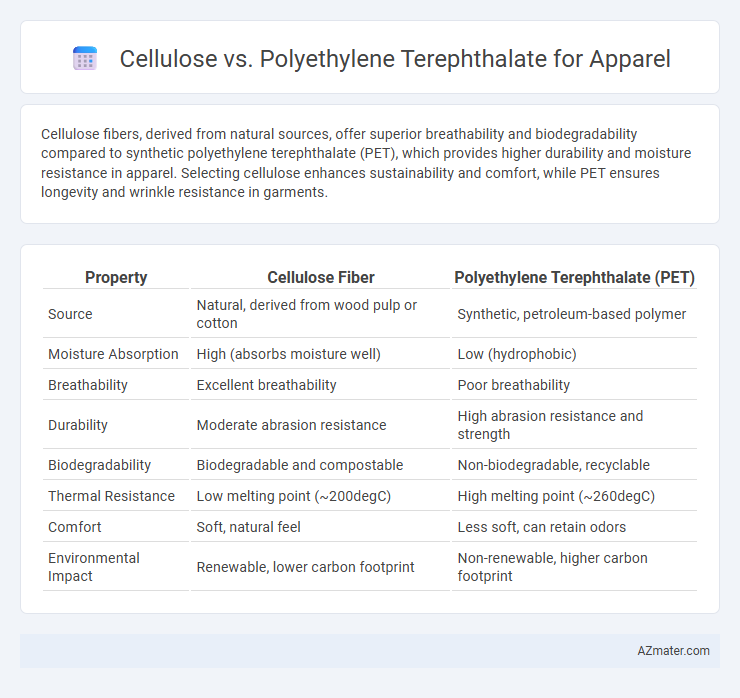Cellulose fibers, derived from natural sources, offer superior breathability and biodegradability compared to synthetic polyethylene terephthalate (PET), which provides higher durability and moisture resistance in apparel. Selecting cellulose enhances sustainability and comfort, while PET ensures longevity and wrinkle resistance in garments.
Table of Comparison
| Property | Cellulose Fiber | Polyethylene Terephthalate (PET) |
|---|---|---|
| Source | Natural, derived from wood pulp or cotton | Synthetic, petroleum-based polymer |
| Moisture Absorption | High (absorbs moisture well) | Low (hydrophobic) |
| Breathability | Excellent breathability | Poor breathability |
| Durability | Moderate abrasion resistance | High abrasion resistance and strength |
| Biodegradability | Biodegradable and compostable | Non-biodegradable, recyclable |
| Thermal Resistance | Low melting point (~200degC) | High melting point (~260degC) |
| Comfort | Soft, natural feel | Less soft, can retain odors |
| Environmental Impact | Renewable, lower carbon footprint | Non-renewable, higher carbon footprint |
Overview of Cellulose and Polyethylene Terephthalate
Cellulose, a natural polymer derived from plant fibers, offers excellent breathability, biodegradability, and moisture-wicking properties, making it a sustainable choice for apparel. Polyethylene terephthalate (PET) is a synthetic polyester known for its durability, wrinkle resistance, and moisture management, widely used in performance and casual wear. Both materials serve distinct roles in textile manufacturing, with cellulose providing eco-friendly benefits and PET delivering high-performance characteristics.
Chemical Structure and Composition
Cellulose, a natural polymer composed of b(1-4) linked D-glucose units, features a linear, crystalline structure that allows for biodegradability and moisture absorption in apparel applications. Polyethylene terephthalate (PET), a synthetic polyester derived from terephthalic acid and ethylene glycol, exhibits a hydrophobic, aromatic ester backbone providing durability, wrinkle resistance, and moisture-wicking properties. The contrasting chemical structures influence fiber performance; cellulose-based fibers offer sustainability and breathability, while PET fibers deliver high tensile strength and resilience in textile manufacturing.
Mechanical Properties in Apparel Applications
Cellulose fibers exhibit high tensile strength, excellent moisture absorption, and superior breathability, making them ideal for comfortable apparel with natural durability. Polyethylene terephthalate (PET) offers enhanced mechanical strength, exceptional abrasion resistance, and dimensional stability, providing long-lasting performance in activewear and outerwear. The choice between cellulose and PET depends on balancing comfort and durability requirements in specific apparel applications.
Moisture Management and Breathability
Cellulose fibers, such as viscose or lyocell, offer superior moisture management in apparel by absorbing and wicking sweat away from the skin, enhancing breathability and comfort. Polyethylene terephthalate (PET) fabrics, commonly known as polyester, are hydrophobic, leading to slower moisture evaporation but excellent durability and shape retention. Blending cellulose with PET often balances breathability and moisture control, making garments suitable for activewear and everyday use.
Environmental Impact and Biodegradability
Cellulose-based fibers, derived from natural sources like wood pulp, exhibit superior biodegradability and lower environmental impact compared to polyethylene terephthalate (PET), a synthetic polymer primarily produced from fossil fuels. Cellulose fibers decompose more rapidly in natural environments, reducing landfill accumulation and microplastic pollution, whereas PET can persist for hundreds of years, contributing significantly to plastic waste and ocean pollution. Sustainable apparel manufacturing increasingly favors cellulose fibers for their renewable origins and lower carbon footprint, aligning with global efforts to mitigate environmental degradation.
Comfort and Skin Sensitivity
Cellulose fibers, such as those derived from cotton or lyocell, offer superior breathability and moisture-wicking properties, enhancing comfort and reducing skin irritation in apparel. Polyethylene terephthalate (PET) fabrics, commonly used in synthetic clothing, provide durability and wrinkle resistance but can trap heat and moisture, potentially causing discomfort and increased skin sensitivity. For consumers with sensitive skin, cellulose-based textiles are generally preferred due to their natural fiber structure and hypoallergenic qualities.
Dyeing and Color Retention
Cellulose fibers, derived from natural sources like cotton and viscose, exhibit excellent dye affinity due to their hydrophilic nature, allowing vibrant and long-lasting color absorption. Polyethylene terephthalate (PET), a synthetic polyester, requires high-temperature disperse dyes to achieve color, which penetrates the fiber surface, yielding good color retention but less breathability. Despite PET's synthetic resilience, cellulose fibers generally outperform in color vibrancy and washfastness for apparel applications, making them preferred for richly dyed garments.
Durability and Maintenance
Cellulose fibers, such as viscose or lyocell, offer moderate durability with good breathability but tend to degrade faster under frequent washing and exposure to sunlight compared to polyethylene terephthalate (PET) fibers. PET fibers, commonly known as polyester, exhibit superior strength, abrasion resistance, and dimensional stability, making them highly durable for long-term apparel use. Maintenance of cellulose-based garments often requires gentler care, including lower washing temperatures and air drying, while PET fabrics tolerate rigorous washing and drying cycles without significant loss of shape or performance.
Cost Efficiency in Textile Manufacturing
Cellulose fibers, derived from renewable sources like cotton and wood pulp, offer cost efficiency in textile manufacturing due to their biodegradability and lower raw material costs compared to petroleum-based polyethylene terephthalate (PET). PET, while providing durability and resistance to chemicals, involves higher production expenses linked to fossil fuel extraction and energy-intensive polymerization processes. Manufacturers balancing cost efficiency and sustainability increasingly favor cellulose fibers to reduce environmental impact and capitalize on lower material and processing costs.
Future Trends and Innovations in Apparel Fibers
Cellulose fibers, derived from renewable sources like wood pulp and cotton, are gaining traction due to their biodegradability and natural breathability, addressing sustainability demands in apparel. Polyethylene terephthalate (PET), a type of polyester made from fossil fuels and increasingly from recycled plastic bottles, offers durability and moisture-wicking properties crucial for high-performance activewear. Future trends highlight a shift towards bio-based PET and enhanced cellulose fiber blends combining environmental benefits with technical advancements such as improved fiber strength and moisture management for innovative, eco-conscious apparel solutions.

Infographic: Cellulose vs Polyethylene terephthalate for Apparel
 azmater.com
azmater.com